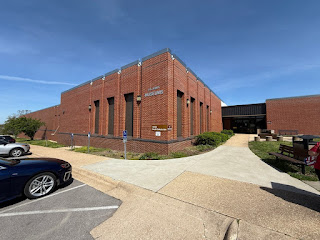The U.S. Army conducts basic combat training at four main locations: Fort Benning, Georgia, Fort Jackson, South Carolina, Fort Sill, Oklahoma, and here at Fort Leonard Wood, Missouri. Where the recruits attend basic training is usually determined by the recruit's assigned military occupational specialty (MOS) and the availability of space at each location. Our grandson will attend at Ft Sill this summer and then Combat Medic school at Fort Sam Houston in San Antonio TX in September.
Fort Leonard Wood is home to three AIT (Advanced Individual Training) schools: Military Police, Combat Engineers and Chemical Warfare. It would make sense that the museums for those disciplines would be located here, and that is exactly what they have done.
Today we explored part of the Fort Leonard Wood's John B. Mahaffey Museum Complex. Mr Mahaffey was the Civilian Aide to the Secretary of the Army and also served in the Army during World War II. The Mahaffey Museum Complex was dedicated in September 2000 and houses three museums: the Military Police Museum, the Army Engineers Museum and the Chemical Corps Museum. The Mahaffey Museum began as the U.S. Army Engineer Museum when it moved from Fort Belvoir, VA, in 1989. The Military Police and Chemical Warfare schools moved to Fort Leonard Wood in 1999 and brought their respective museums to the complex. We did not know that the museum complex is also adjacent to the WWII Army Complex Museum which replicates Fort Leonard Wood as it was during the 1940s. They also have an outdoors vehicle display. We will seek those out tomorrow.
We started in the Engineer's Museum which has over 10,000 square feet of galleries that present the history of the Army Corps of Engineers from the American Revolution to the modern era. The Engineers, also known as "Sappers", use engineering equipment, topographic engineering, landmine warfare, tactical bridging, special weapons, and much more. They are involved with not only building but demolition. A small fraction of the pictures I took:
The U.S. Army Chemical Corps Museum features artifact exhibits, immersion dioramas, graphics, and text, displayed in a 9,000 square foot gallery, illustrating the history of the Corps from 1917 to the present.
The U.S. Army Military Police Museum is currently home to over 5,000 artifacts, including textiles, MP insignia, equipment, weapons, and vehicles encompassing the history of the Military Police from 1775.
From the museum we made a stop at military clothing and a few other shops nearby, grabbed some lunch at Qdoba and then headed back to the campground. Nearby is the Army Incident Response Training Department. That explains the nasty-looking bus-tanker accident on the road! It looks very realistic! With my 25 years on the fire department, we were hoping to see a response to this and how they handle it, but we did not see it. Maybe tomorrow.
The weather is gorgeous here, so we sat outside, grilled some burgers, steaks, onions and sweet potatoes, and enjoyed the evening.
We found out today the stagecoach stop museum is not open until Saturday so we won't be able to go inside, but we will stop by there tomorrow also.






































No comments:
Post a Comment